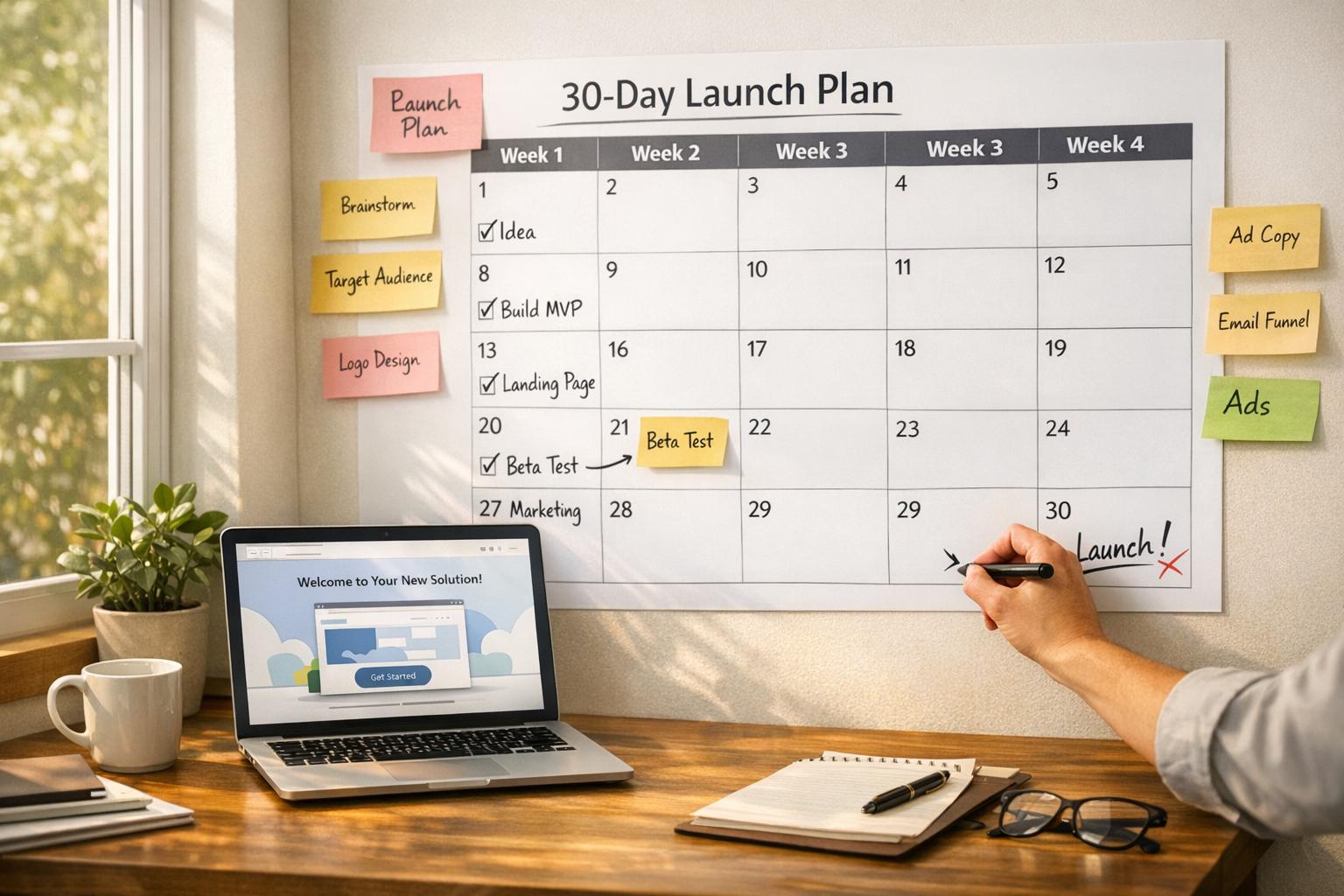
Want to know if your business idea will succeed? The 5-Day Business Validation Challenge helps you test your idea quickly and effectively. In just five days, you'll refine your concept, analyze your market, gather customer feedback, calculate financials, and create a business plan. Here's how it works:
- Day 1: Define your idea and target audience. Write a clear business summary and build detailed customer profiles.
- Day 2: Research your market size and competitors. Use tools to calculate potential customers and identify market gaps.
- Day 3: Test your solution. Validate your value proposition with real customer feedback.
- Day 4: Check financials. Set pricing, calculate startup costs, and perform a break-even analysis.
- Day 5: Build your business plan. Combine all insights into a full plan and a one-page Lean Canvas.
12 Best Ways to Test and Validate Your Business Idea
Day 1: Map Your Core Business Concept
Day 1 is all about laying the groundwork for your business by defining your concept and identifying your target market. This step sets the stage for future validation.
Write Your Business Summary
Start by creating a short and clear business summary that answers the 5 W's - Who, What, Why, When, Where. Include these key elements:
- Mission
- What you’re offering
- Target audience
- Opportunities for growth
- Financial outlook
- Major milestones
"A great summary is one of the key features of a business plan. It serves as an overview of your entire business and the elements surrounding it." - Debbie Austin FCCA, Wellers Accountants
Use tools like the Business Summary Generator to organize your ideas quickly. Keep it concise for now; you'll refine and expand on it later.
Build Customer Profiles
Next, focus on identifying your ideal customers. Go beyond basic demographics to create detailed personas that truly represent your audience. Solely relying on demographics could mean missing out on many potential buyers.
Demographics to Consider:
- Age and location
- Income and job type
- Education level and family status
Behavioral Insights to Explore:
- Their goals and motivations
- Common challenges or pain points
- Shopping habits and preferences
- Factors that influence their decisions
"Even if it means taking a couple of months to really nail it down, what's a couple of months in the roughly 5-10 years you'll spend betting on this customer to build and grow the company?" - Julie Supan, former Head of Marketing at YouTube
Leverage tools like the Customer Profiling tool, which uses AI to uncover patterns and insights you might miss on your own.
Day 1 Output
By the end of Day 1, you should have:
- A one-page summary outlining your business concept
- 2-3 detailed customer personas representing your main audience segments
- An initial validation score showing how well your idea aligns with the market
"You're nothing until you have customers who want your product." - Gagan Biyani, co-founder and CEO at Maven
These outputs are essential as you move into deeper market research on Day 2.
Day 2: Research Market Size and Competitors
With your business concept and target audience defined, the next step is to dig into market research and analyze competitors. This will help you confirm your business opportunity and refine your approach.
Calculate Market Size
Knowing your market size is key to understanding your business's potential. Break it down into three categories:
- Total Addressable Market (TAM): The entire market for your product or service.
- Serviceable Available Market (SAM): The portion of the market you can realistically target.
- Serviceable Obtainable Market (SOM): The share of the market you can reasonably capture.
Using tools like the Market Size Assessment tool can simplify this process by analyzing market data and customer behavior. For example, AI tools have been shown to reduce market research costs by up to $10,000.
"There's more innovation in here than a straightforward business plan." - Andy Day, CEO - Capital A
Key Factors to Consider for Market Sizing:
- How many potential customers are in your target region?
- What is the average purchase value?
- How often do customers make purchases?
- What is the market's growth rate?
- Are there seasonal trends you need to account for?
Map Competitor Landscape
Understanding your competition is just as important as knowing your market. Porter's Five Forces framework is a great way to analyze your competitive environment:
- Competitive rivalry
- Supplier power
- Buyer power
- Threat of new entrants
- Threat of substitutes
The Competitor Analysis Generator can help you identify both direct and indirect competitors. It evaluates their:
- Product offerings and pricing
- Market positioning
- Customer engagement
- Marketing tactics
- Strengths and weaknesses
"Competitive analysis is a strategic tool that acts as a shield and sword." - Junior Madureira, CEO of CompanyCraft
Steps for Competitive Research:
1. Identify Competitors
Use industry-specific keywords and directories to list both direct and indirect competitors. Aim for a thorough overview of your competitive landscape.
2. Examine Their Online Presence
Check out competitor websites, social media profiles, and customer reviews. This gives you a sense of their marketing strategies and customer engagement.
3. Analyze Pricing Models
Take note of key pricing details, such as:
- Base prices
- Package options
- Discount strategies
- Payment terms
These insights will help you craft a pricing and positioning strategy that stands out.
Day 2 Output
By the end of today, you should have:
- A detailed market size report, including TAM, SAM, and SOM.
- A competitive analysis document that highlights key players and identifies market gaps.
- A positioning strategy informed by competitor strengths and weaknesses.
With these insights, you'll be ready to refine your solution and start testing on Day 3.
sbb-itb-08dd11e
Day 3: Test Your Solution
It's time to validate your solution with real customers.
Define Your Value Proposition
Your value proposition should clearly explain how your solution addresses customer problems. The Value Proposition Canvas can help match customer needs with the benefits you offer.
Key elements to focus on:
- Customer jobs and needs
- Pain points and risks
- Benefits and gains
- Your solution's standout features
- How it resolves pain points
- Ways it delivers value
For example, a customer feedback analysis tool boosted its clients' Net Promoter Score (NPS) by 20 points by offering automated analysis. This saved over $200,000 in labor costs and cut analysis time by 95%.
Collect Customer Feedback
Gather direct feedback to confirm your solution fits the market. Here’s how:
-
Pick Your Methods
Options include customer interviews, online surveys, focus groups, usability tests, social media listening, and review platforms. -
Ask Targeted Questions
Examples:
Problem validation: "How are you currently solving this issue?"
Solution fit: "Does this solution work for you?"
Pricing: "What would you pay for this?"
Feature priorities: "Which features are most important?" -
Analyze and Take Action
Use AI tools to process feedback quickly. For instance, one company improved its customer experience by using AI to identify key issues and prioritize fixes.
These steps will guide you toward actionable improvements.
Day 3 Output
By the end of Day 3, aim to achieve:
- A clearly tested value proposition
- Feedback from at least 10 potential users
- Key insights and necessary adjustments
- A prioritized list of improvements
Day 4: Check Financial Numbers
Now that you’ve gathered customer feedback, it’s time to dive into your financials. After testing your solution, make sure the numbers align with your goals.
Set Your Pricing
Getting your pricing right is critical. Research indicates that 38% of startups fail because they run out of money.
Here’s what to consider:
- Fixed costs: These include monthly expenses like salaries, insurance, licenses, equipment, technology, and marketing.
- Variable costs: Think of production materials, shipping fees, transaction charges, commissions, and inventory storage.
Use a break-even analysis to determine pricing that covers your costs while leaving room for profit.
Calculate Startup Costs
Lay out your initial investment requirements.
Here’s a snapshot of typical startup expenses for 2025:
| Expense Category | Typical Cost Range |
|---|---|
| Business Formation | $100 – $800 |
| Insurance & Permits | $700 – $1,500/year |
| Equipment (5-person team) | $5,000 – $15,000 |
| Marketing Budget | $5,000+/month |
| Office Space | $1,500 – $3,000/month |
| Tech Infrastructure | $300 – $1,300/year |
"Break-even analysis helps business owners understand when to expect a profit, which is essential in developing a strategy for covering costs or accelerating growth." - Indeed Employer Content Team
To calculate your break-even point, use this formula:
Break-even Units = Fixed Costs ÷ (Price - Variable Costs).
Don’t forget to add a 10–20% contingency fund for unexpected expenses.
Day 4 Output
By the end of Day 4, you should have:
- A pricing strategy that ensures profitability
- A detailed breakdown of your startup costs
- A completed break-even analysis
- A 12-month financial projection
- A list of potential funding sources
Day 5: Build Your Business Plan
Once you've validated your idea, it's time to formalize your business plan. Regular market research can provide up to a 60% edge over competitors, making this step especially important.
Write Your Full Business Plan
Using the insights from your validation process, craft a detailed plan that includes these essential sections:
| Section | Key Elements |
|---|---|
| Executive Summary | Overview of your concept, market opportunity, and financial projections |
| Market Analysis | Highlights of the research and insights gathered during validation |
| Financial Plan | Financial details and projections confirmed during Day 4 |
| Operations | • Business structure • Team needs • Technology requirements • Supply chain details |
"Access to accurate and comprehensive market data is critical for developing a robust business plan" - Experts at Fordham University Libraries
Create Your Lean Canvas
After completing your detailed plan, condense it into a one-page Lean Canvas. This tool helps you summarize your business model clearly and concisely:
- Problem-Solution Fit: Show how your solution directly addresses the needs you've identified.
- Value Proposition: Highlight what sets you apart, based on competitor analysis and customer insights.
- Financial Viability: Include your revenue streams and cost structure, backed by validated data.
Day 5 Output
By the end of Day 5, you should have:
- A complete business plan that integrates all findings from the validation process
- A concise Lean Canvas summarizing your model
- A timeline for implementation
- A clear list of next steps to prepare for launch
- Presentation materials ready for stakeholders
Next Steps After Validation
After validating your idea in just five days, it’s time to turn it into a real business. Use the insights and outputs from your validation process to simplify your launch preparations.
Refine Your Business Materials
Use what you’ve learned during validation to create polished business documents:
| Document Type | Key Components | Purpose |
|---|---|---|
| Business Plan | Market analysis, financial projections, operational details | A detailed roadmap for execution |
| Lean Canvas | One-page business model summary | A concise overview for stakeholders |
| Pitch Deck | Visual presentation of key business elements | Perfect for investor and partner meetings |
Address Validation Gaps
Revisit your 5-day validation scores and feedback to strengthen weaker areas. Focus on:
- Market size estimates
- Incorporating customer feedback
- Ensuring financial projections are accurate
- Sharpening your competitive positioning
"IdeaFloat walks you through a step-by-step plan to discover, validate and launch your business." - Lachlan Nicolson, Business Coach at Leader Guide
Prepare for Launch
With your groundwork complete, plan your launch timeline. Include steps like legal registration, securing funding, marketing strategies, and setting up operations.
Share Your Vision
Present your refined business concept to stakeholders. Highlight key points such as:
- Market size evaluation
- Customer insights gathered
- Competitor analysis
- Financial projections
"IdeaFloat will save me and my team countless hours of work, as we help clients articulate their business ideas." - Robert Bates, Partner at McFillin Accounting
Related posts
Get the newest tips and tricks of starting your business!


